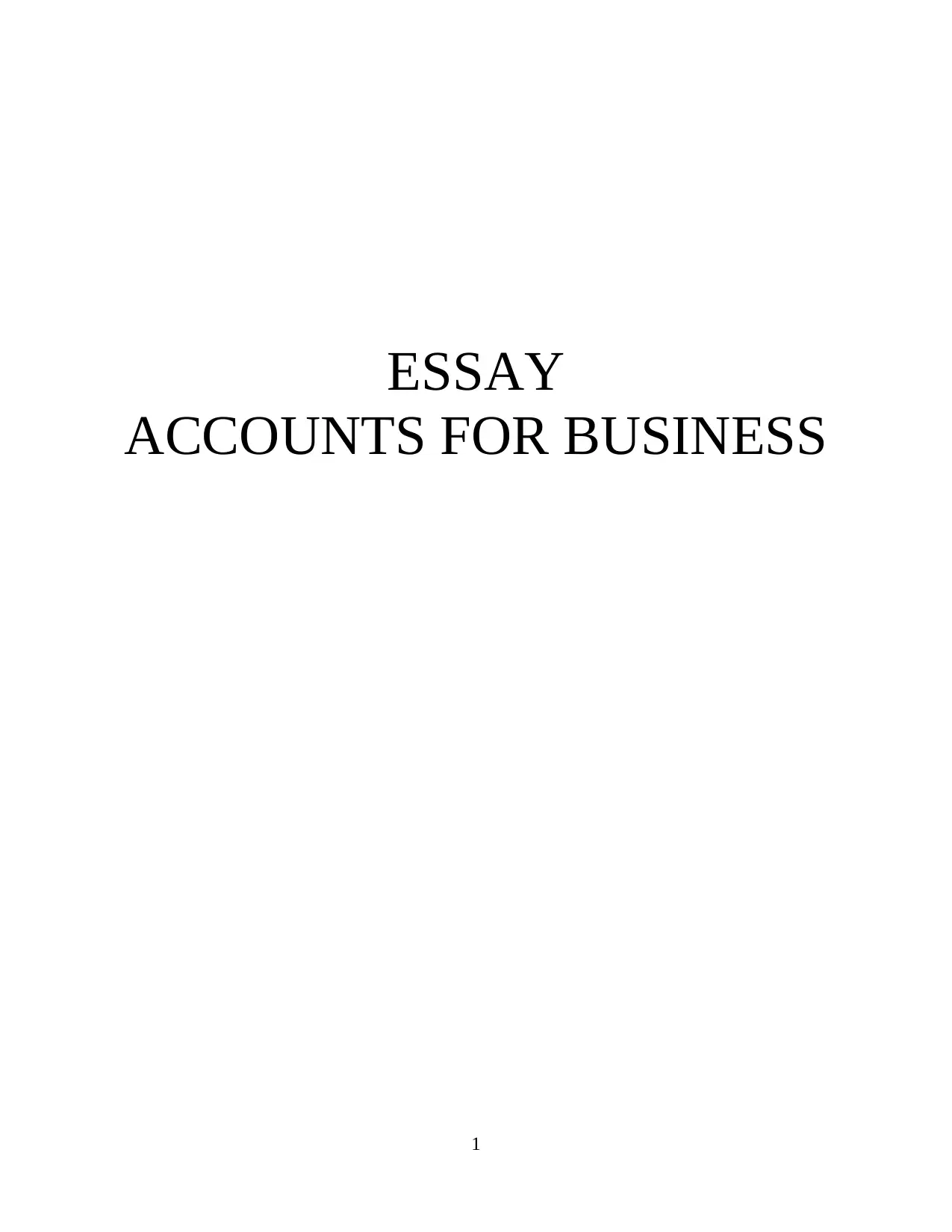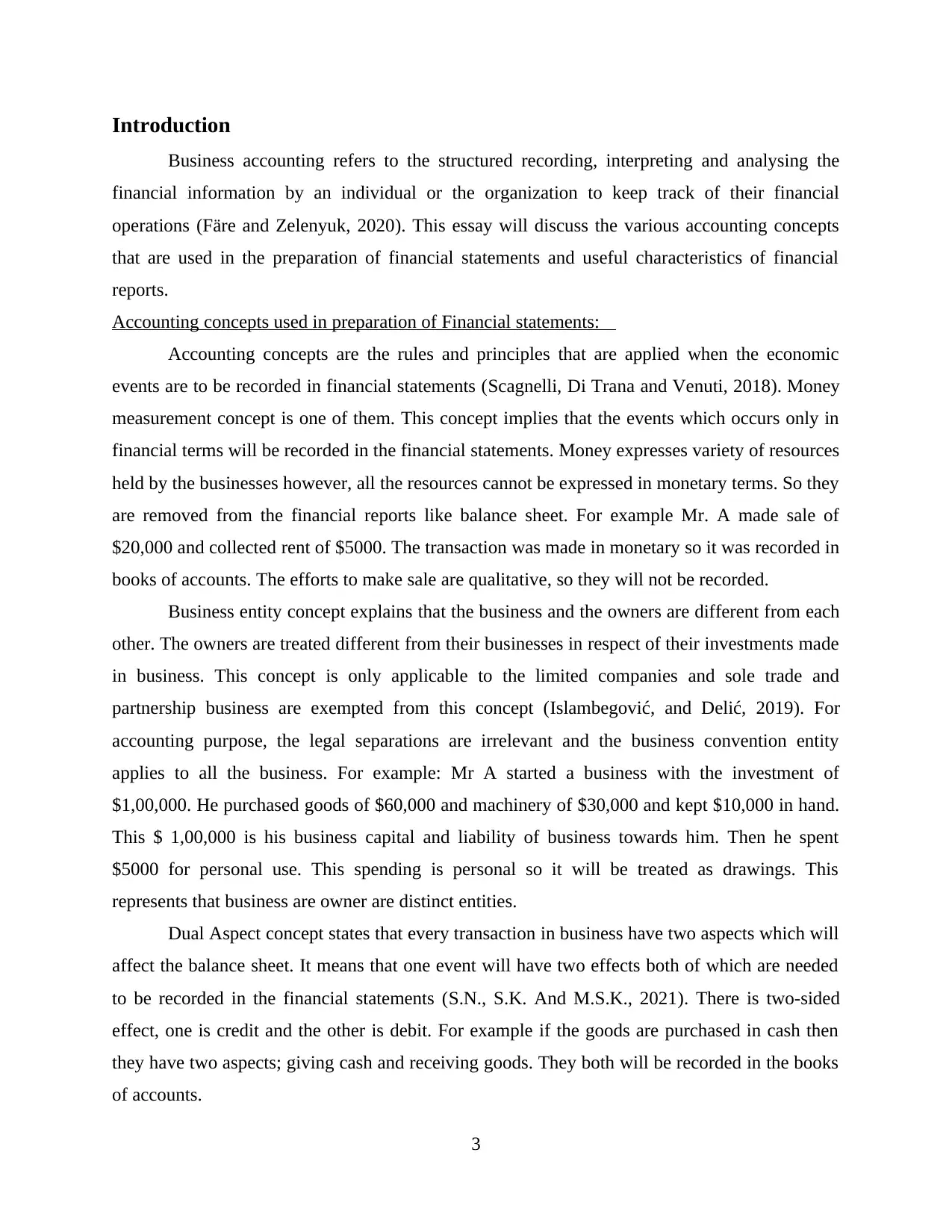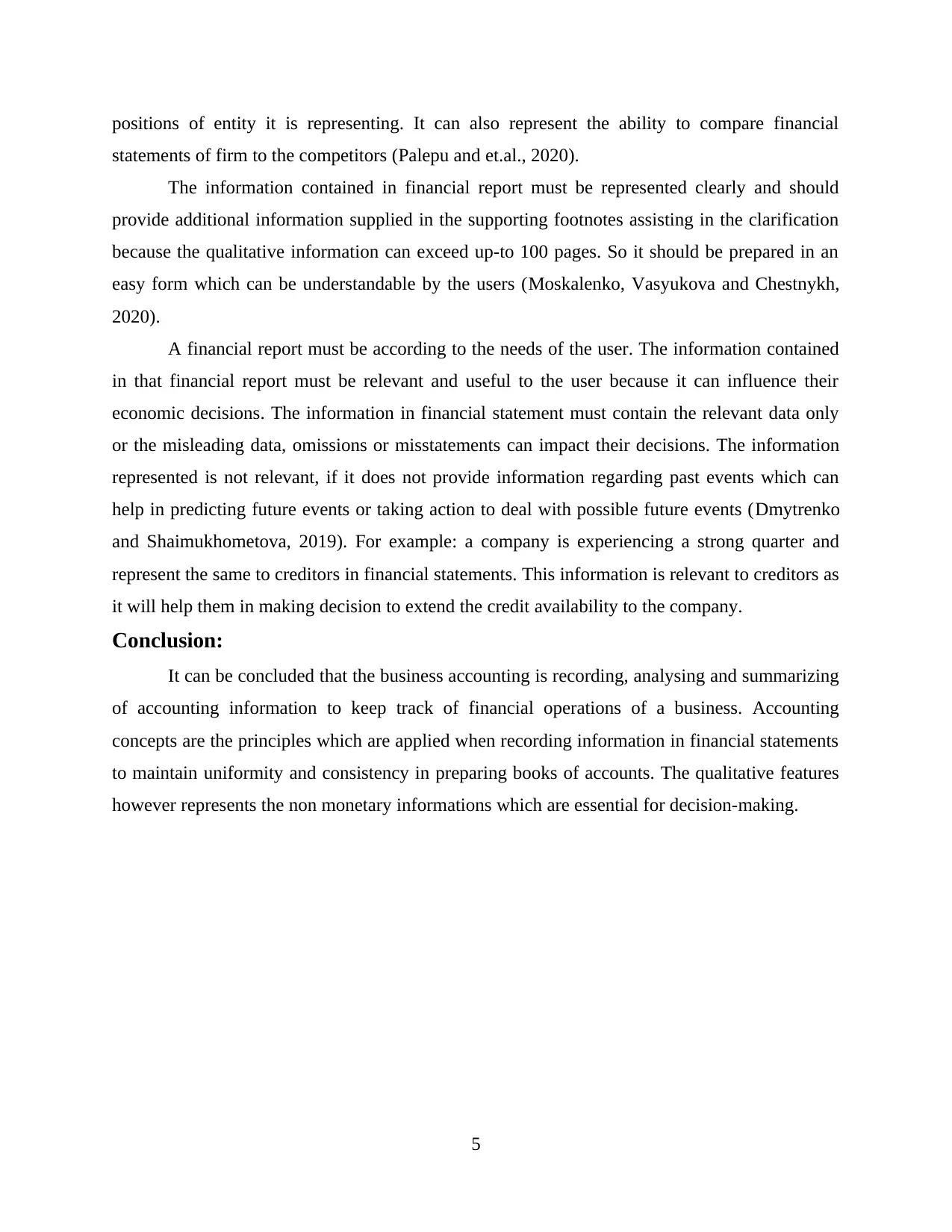A Detailed Review of Accounting Concepts and Financial Reports
VerifiedAdded on 2023/06/18
|6
|1545
|95
Essay
AI Summary
This essay provides a detailed analysis of accounting concepts used in the preparation of financial statements, emphasizing their importance in tracking financial operations. It covers concepts like money measurement, business entity, dual aspect, matching, and going concern, illustrating each with practical examples. Furthermore, the essay discusses the qualitative characteristics of financial reports, such as reliability, verifiability, comparability, and relevance, highlighting how these non-monetary aspects are crucial for informed decision-making by investors and other stakeholders. The conclusion underscores the significance of both accounting concepts and qualitative features in ensuring the accuracy and utility of financial information.

ESSAY
ACCOUNTS FOR BUSINESS
1
ACCOUNTS FOR BUSINESS
1
Paraphrase This Document
Need a fresh take? Get an instant paraphrase of this document with our AI Paraphraser

Table of Contents
Introduction......................................................................................................................................3
Accounting concepts used in preparation of Financial statements: ............................................4
Qualitative characteristics of Financial reports:..........................................................................5
Conclusion:......................................................................................................................................6
REFERENCES................................................................................................................................7
2
Introduction......................................................................................................................................3
Accounting concepts used in preparation of Financial statements: ............................................4
Qualitative characteristics of Financial reports:..........................................................................5
Conclusion:......................................................................................................................................6
REFERENCES................................................................................................................................7
2

Introduction
Business accounting refers to the structured recording, interpreting and analysing the
financial information by an individual or the organization to keep track of their financial
operations (Färe and Zelenyuk, 2020). This essay will discuss the various accounting concepts
that are used in the preparation of financial statements and useful characteristics of financial
reports.
Accounting concepts used in preparation of Financial statements:
Accounting concepts are the rules and principles that are applied when the economic
events are to be recorded in financial statements (Scagnelli, Di Trana and Venuti, 2018). Money
measurement concept is one of them. This concept implies that the events which occurs only in
financial terms will be recorded in the financial statements. Money expresses variety of resources
held by the businesses however, all the resources cannot be expressed in monetary terms. So they
are removed from the financial reports like balance sheet. For example Mr. A made sale of
$20,000 and collected rent of $5000. The transaction was made in monetary so it was recorded in
books of accounts. The efforts to make sale are qualitative, so they will not be recorded.
Business entity concept explains that the business and the owners are different from each
other. The owners are treated different from their businesses in respect of their investments made
in business. This concept is only applicable to the limited companies and sole trade and
partnership business are exempted from this concept (Islambegović, and Delić, 2019). For
accounting purpose, the legal separations are irrelevant and the business convention entity
applies to all the business. For example: Mr A started a business with the investment of
$1,00,000. He purchased goods of $60,000 and machinery of $30,000 and kept $10,000 in hand.
This $ 1,00,000 is his business capital and liability of business towards him. Then he spent
$5000 for personal use. This spending is personal so it will be treated as drawings. This
represents that business are owner are distinct entities.
Dual Aspect concept states that every transaction in business have two aspects which will
affect the balance sheet. It means that one event will have two effects both of which are needed
to be recorded in the financial statements (S.N., S.K. And M.S.K., 2021). There is two-sided
effect, one is credit and the other is debit. For example if the goods are purchased in cash then
they have two aspects; giving cash and receiving goods. They both will be recorded in the books
of accounts.
3
Business accounting refers to the structured recording, interpreting and analysing the
financial information by an individual or the organization to keep track of their financial
operations (Färe and Zelenyuk, 2020). This essay will discuss the various accounting concepts
that are used in the preparation of financial statements and useful characteristics of financial
reports.
Accounting concepts used in preparation of Financial statements:
Accounting concepts are the rules and principles that are applied when the economic
events are to be recorded in financial statements (Scagnelli, Di Trana and Venuti, 2018). Money
measurement concept is one of them. This concept implies that the events which occurs only in
financial terms will be recorded in the financial statements. Money expresses variety of resources
held by the businesses however, all the resources cannot be expressed in monetary terms. So they
are removed from the financial reports like balance sheet. For example Mr. A made sale of
$20,000 and collected rent of $5000. The transaction was made in monetary so it was recorded in
books of accounts. The efforts to make sale are qualitative, so they will not be recorded.
Business entity concept explains that the business and the owners are different from each
other. The owners are treated different from their businesses in respect of their investments made
in business. This concept is only applicable to the limited companies and sole trade and
partnership business are exempted from this concept (Islambegović, and Delić, 2019). For
accounting purpose, the legal separations are irrelevant and the business convention entity
applies to all the business. For example: Mr A started a business with the investment of
$1,00,000. He purchased goods of $60,000 and machinery of $30,000 and kept $10,000 in hand.
This $ 1,00,000 is his business capital and liability of business towards him. Then he spent
$5000 for personal use. This spending is personal so it will be treated as drawings. This
represents that business are owner are distinct entities.
Dual Aspect concept states that every transaction in business have two aspects which will
affect the balance sheet. It means that one event will have two effects both of which are needed
to be recorded in the financial statements (S.N., S.K. And M.S.K., 2021). There is two-sided
effect, one is credit and the other is debit. For example if the goods are purchased in cash then
they have two aspects; giving cash and receiving goods. They both will be recorded in the books
of accounts.
3
⊘ This is a preview!⊘
Do you want full access?
Subscribe today to unlock all pages.

Trusted by 1+ million students worldwide

The matching concept of the accounts states that the revenue and expenses incurred by
business must belong to same accounting period. It implies that all the all revenues and costs
incurred in an accounting year should be considered while ascertaining the profit or loss in
financial statements (Gentry, 2018.). For example; Company A made annual expenses of $5000
and the revenue generated was $10,000. The amounts are matched to figure profit or loss. Here
the comparison resulted in profit of $5000.
Going concern concept of accounting states that the company will continue to carry its
business in an infinite period. It simply means that the business has continuity of life and it will
not be dissolved in the near future (Čičak, 2018). For example: Company B purchased a
machinery of $20,000 whose span life is 5 years. Every year some amount will be shown as
expense on machinery and the remaining will be treated as an asset. The machinery purchased
will be used in business for many years thus it will not be proper to charge the amount from
revenue in the year the machinery was purchased. Only a part of value will be treated as an
expense in the year it was purchased and remaining balance will be treated as an asset to the
Company B.
Qualitative characteristics of Financial reports:
The financial reports are the formal records of financial activities of an organization or
individual. The qualitative characteristics of a financial report are the features which cannot be
expressed or values in the monetary terms. Investors, creditors or the other users of financial
statements can demand accounting information which can be represented only in qualitative form
(Lessambo, 2018). The qualitative information could be equally important to the users of
financial statements as the quantitative information is. A financial report should be reliable and
verifiable. It means the information contained must not include material errors or biasness or
misleading. The information should represent the translations and events which are actual. The
financial statement must represent the estimations and uncertainties through proper disclosures.
The financial report's information must be comparable. It means that the report should
represent the information which can be comparable to other financial informations presented for
other accounting periods. The information which is comparable and consist accounting standards
and policies can enable users to draw relevant conclusions about performance and trends of the
company. This will facilitate the users of financial statements in identifying the performance and
4
business must belong to same accounting period. It implies that all the all revenues and costs
incurred in an accounting year should be considered while ascertaining the profit or loss in
financial statements (Gentry, 2018.). For example; Company A made annual expenses of $5000
and the revenue generated was $10,000. The amounts are matched to figure profit or loss. Here
the comparison resulted in profit of $5000.
Going concern concept of accounting states that the company will continue to carry its
business in an infinite period. It simply means that the business has continuity of life and it will
not be dissolved in the near future (Čičak, 2018). For example: Company B purchased a
machinery of $20,000 whose span life is 5 years. Every year some amount will be shown as
expense on machinery and the remaining will be treated as an asset. The machinery purchased
will be used in business for many years thus it will not be proper to charge the amount from
revenue in the year the machinery was purchased. Only a part of value will be treated as an
expense in the year it was purchased and remaining balance will be treated as an asset to the
Company B.
Qualitative characteristics of Financial reports:
The financial reports are the formal records of financial activities of an organization or
individual. The qualitative characteristics of a financial report are the features which cannot be
expressed or values in the monetary terms. Investors, creditors or the other users of financial
statements can demand accounting information which can be represented only in qualitative form
(Lessambo, 2018). The qualitative information could be equally important to the users of
financial statements as the quantitative information is. A financial report should be reliable and
verifiable. It means the information contained must not include material errors or biasness or
misleading. The information should represent the translations and events which are actual. The
financial statement must represent the estimations and uncertainties through proper disclosures.
The financial report's information must be comparable. It means that the report should
represent the information which can be comparable to other financial informations presented for
other accounting periods. The information which is comparable and consist accounting standards
and policies can enable users to draw relevant conclusions about performance and trends of the
company. This will facilitate the users of financial statements in identifying the performance and
4
Paraphrase This Document
Need a fresh take? Get an instant paraphrase of this document with our AI Paraphraser

positions of entity it is representing. It can also represent the ability to compare financial
statements of firm to the competitors (Palepu and et.al., 2020).
The information contained in financial report must be represented clearly and should
provide additional information supplied in the supporting footnotes assisting in the clarification
because the qualitative information can exceed up-to 100 pages. So it should be prepared in an
easy form which can be understandable by the users (Moskalenko, Vasyukova and Chestnykh,
2020).
A financial report must be according to the needs of the user. The information contained
in that financial report must be relevant and useful to the user because it can influence their
economic decisions. The information in financial statement must contain the relevant data only
or the misleading data, omissions or misstatements can impact their decisions. The information
represented is not relevant, if it does not provide information regarding past events which can
help in predicting future events or taking action to deal with possible future events (Dmytrenko
and Shaimukhometova, 2019). For example: a company is experiencing a strong quarter and
represent the same to creditors in financial statements. This information is relevant to creditors as
it will help them in making decision to extend the credit availability to the company.
Conclusion:
It can be concluded that the business accounting is recording, analysing and summarizing
of accounting information to keep track of financial operations of a business. Accounting
concepts are the principles which are applied when recording information in financial statements
to maintain uniformity and consistency in preparing books of accounts. The qualitative features
however represents the non monetary informations which are essential for decision-making.
5
statements of firm to the competitors (Palepu and et.al., 2020).
The information contained in financial report must be represented clearly and should
provide additional information supplied in the supporting footnotes assisting in the clarification
because the qualitative information can exceed up-to 100 pages. So it should be prepared in an
easy form which can be understandable by the users (Moskalenko, Vasyukova and Chestnykh,
2020).
A financial report must be according to the needs of the user. The information contained
in that financial report must be relevant and useful to the user because it can influence their
economic decisions. The information in financial statement must contain the relevant data only
or the misleading data, omissions or misstatements can impact their decisions. The information
represented is not relevant, if it does not provide information regarding past events which can
help in predicting future events or taking action to deal with possible future events (Dmytrenko
and Shaimukhometova, 2019). For example: a company is experiencing a strong quarter and
represent the same to creditors in financial statements. This information is relevant to creditors as
it will help them in making decision to extend the credit availability to the company.
Conclusion:
It can be concluded that the business accounting is recording, analysing and summarizing
of accounting information to keep track of financial operations of a business. Accounting
concepts are the principles which are applied when recording information in financial statements
to maintain uniformity and consistency in preparing books of accounts. The qualitative features
however represents the non monetary informations which are essential for decision-making.
5

REFERENCES
Books and journals
Čičak, J., 2018. Accounting Concept Of Long-Term Conservation Values Of Enterprises.
Poslovna izvrsnost. 12(1). pp.131-140.
Dmytrenko, I.M. and Shaimukhometova, N.V., 2019. Consolidation of Specific Items of
Financial Statements of Company Group: Principles, Conditions and Features. Statistics
of Ukraine. 87(4). pp.117-128.
Färe, R. and Zelenyuk, V., 2020. Profit efficiency: Generalization, business accounting and the
role of convexity. Economics Letters. 196. p.109483.
Gentry, M.E., 2018. Concepts of Accounting: A Case Study Compilation (Doctoral dissertation,
The University of Mississippi).
Islambegović, S.N. and Delić, E., 2019. THE IMPACT OF THE APPLICATION OF THE
ACCOUNTING CONCEPT OF FAIR VALUE ON THE QUALITY OF FINANCIAL
STATEMENTS OF BUSINESS ENTITIES IN BOSNIA AND HERZEGOVINA.
Ekonomski Vjesnik. 32(1).
Lessambo, F.I., 2018. Financial Statements. Analysis and Reporting.
Maheshwari, S.N., Maheshwari, S.K. and Maheshwari, M.S.K., 2021. Principles of Management
Accounting. Sultan Chand & Sons.
Moskalenko, N.V., Vasyukova, E.S. and Chestnykh, D.O., 2020. Features of the reflection of
inventories in the financial statements. Entrepreneur’ s Guide.
Palepu, K.G. and et.al., 2020. Business analysis and valuation: Using financial statements.
Cengage AU.
Scagnelli, S.D., Di Trana, M.G. and Venuti, F., 2018. Introduction to Financial Accounting:
Concepts, Cases and Exercises. G Giappichelli Editore.
6
Books and journals
Čičak, J., 2018. Accounting Concept Of Long-Term Conservation Values Of Enterprises.
Poslovna izvrsnost. 12(1). pp.131-140.
Dmytrenko, I.M. and Shaimukhometova, N.V., 2019. Consolidation of Specific Items of
Financial Statements of Company Group: Principles, Conditions and Features. Statistics
of Ukraine. 87(4). pp.117-128.
Färe, R. and Zelenyuk, V., 2020. Profit efficiency: Generalization, business accounting and the
role of convexity. Economics Letters. 196. p.109483.
Gentry, M.E., 2018. Concepts of Accounting: A Case Study Compilation (Doctoral dissertation,
The University of Mississippi).
Islambegović, S.N. and Delić, E., 2019. THE IMPACT OF THE APPLICATION OF THE
ACCOUNTING CONCEPT OF FAIR VALUE ON THE QUALITY OF FINANCIAL
STATEMENTS OF BUSINESS ENTITIES IN BOSNIA AND HERZEGOVINA.
Ekonomski Vjesnik. 32(1).
Lessambo, F.I., 2018. Financial Statements. Analysis and Reporting.
Maheshwari, S.N., Maheshwari, S.K. and Maheshwari, M.S.K., 2021. Principles of Management
Accounting. Sultan Chand & Sons.
Moskalenko, N.V., Vasyukova, E.S. and Chestnykh, D.O., 2020. Features of the reflection of
inventories in the financial statements. Entrepreneur’ s Guide.
Palepu, K.G. and et.al., 2020. Business analysis and valuation: Using financial statements.
Cengage AU.
Scagnelli, S.D., Di Trana, M.G. and Venuti, F., 2018. Introduction to Financial Accounting:
Concepts, Cases and Exercises. G Giappichelli Editore.
6
⊘ This is a preview!⊘
Do you want full access?
Subscribe today to unlock all pages.

Trusted by 1+ million students worldwide
1 out of 6
Related Documents
Your All-in-One AI-Powered Toolkit for Academic Success.
+13062052269
info@desklib.com
Available 24*7 on WhatsApp / Email
![[object Object]](/_next/static/media/star-bottom.7253800d.svg)
Unlock your academic potential
Copyright © 2020–2025 A2Z Services. All Rights Reserved. Developed and managed by ZUCOL.





